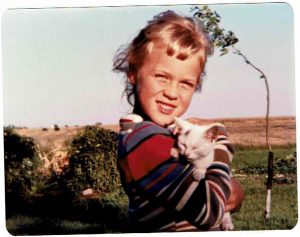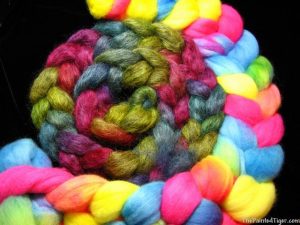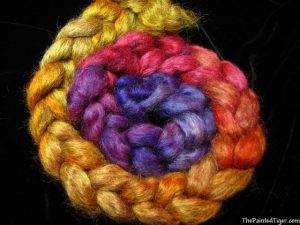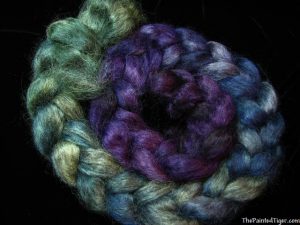Behind the Scenes: Indie Dyer Brooke Logan of The Painted Tiger
We have been lucky enough to work with Brooke Logan from The Painted Tiger on a number of PLY projects. Today, we’ve got a sneak peek behind the scenes into Brooke’s business and a giveaway of her gorgeous Gotland fiber!
About The Painted Tiger
 It is always interesting to hear how people got into the fiber arts for a career. My story is a long-ish and convoluted one. I grew up on a small homestead, and my mom raised orphan lambs, both to help with the endless lawn mowing and for some pin money. I got to help feed the bottle lambs. One summer, Mom went off to Siever’s School of Fiber Arts in Wisconsin and returned with a spindle and all kinds of plans for spinning and weaving. She established a flock of brown sheep and bought a spinning wheel and handcards. Her plans fizzled after the first lambing season – and the first giant felt donut she made in the washing machine – and when the ram came after my brother and me – but we still had orphan lambs every year from spring to fall. One year, she got them just in time for my Spring Break! (Because they are newborns, orphan lambs need to be fed every 4 hours around the clock the first week.)
It is always interesting to hear how people got into the fiber arts for a career. My story is a long-ish and convoluted one. I grew up on a small homestead, and my mom raised orphan lambs, both to help with the endless lawn mowing and for some pin money. I got to help feed the bottle lambs. One summer, Mom went off to Siever’s School of Fiber Arts in Wisconsin and returned with a spindle and all kinds of plans for spinning and weaving. She established a flock of brown sheep and bought a spinning wheel and handcards. Her plans fizzled after the first lambing season – and the first giant felt donut she made in the washing machine – and when the ram came after my brother and me – but we still had orphan lambs every year from spring to fall. One year, she got them just in time for my Spring Break! (Because they are newborns, orphan lambs need to be fed every 4 hours around the clock the first week.)
Fast forward to 2002 when I was a SAHM with a toddler, looking to make my own pin money. Ebay was a great work-at-home option, and after many tries at a username, The Painted Tiger was it! Looking for a more consistent product to sell to streamline shipping, I started making custom knit striped scarves, which tied in with the Tiger part quite well. In 2004, I joined the community choir that had just formed and found myself in charge of wardrobe. When I couldn’t find the scarves and ties I wanted to reflect the “river” part of our choir name, I learned how to dye them.
 In the process of my research, I discovered the new indie dyer scene. I had enjoyed dyeing the scarves and ties and was ready to apply my knowledge to yarn – voila, Painted! I started selling on Ebay and Etsy and then launched ThePaintedTiger.com in 2008. I improved my childhood spinning skills and decided to dye fiber, too. In keeping with my business name, I specialize in handpainted colorways and enjoy making stripes and gradients on yarn and fiber. One of my favorite things to dye is for Tiger Club, my monthly yarn and/or fiber club, because I love to come up with new ways to put color on wool, and it gives me an excuse to try new fibers, as I try to offer a different one each month of the year.
In the process of my research, I discovered the new indie dyer scene. I had enjoyed dyeing the scarves and ties and was ready to apply my knowledge to yarn – voila, Painted! I started selling on Ebay and Etsy and then launched ThePaintedTiger.com in 2008. I improved my childhood spinning skills and decided to dye fiber, too. In keeping with my business name, I specialize in handpainted colorways and enjoy making stripes and gradients on yarn and fiber. One of my favorite things to dye is for Tiger Club, my monthly yarn and/or fiber club, because I love to come up with new ways to put color on wool, and it gives me an excuse to try new fibers, as I try to offer a different one each month of the year.
About Gotland Wool
 It is believed that Gotland sheep originated from sheep brought by the Vikings to the Swedish island of Gotland. The original Gutefår sheep were horned, with no belly wool and white markings around the eyes and nose. In the 1920s, the Gotland sheep was developed by a farmer who wished to refine the breed and saw a ram he liked being transported on a train to slaughter. He purchased the ram and started a breeding program to create a polled (no horns) sheep with a beautiful curly fleece.
It is believed that Gotland sheep originated from sheep brought by the Vikings to the Swedish island of Gotland. The original Gutefår sheep were horned, with no belly wool and white markings around the eyes and nose. In the 1920s, the Gotland sheep was developed by a farmer who wished to refine the breed and saw a ram he liked being transported on a train to slaughter. He purchased the ram and started a breeding program to create a polled (no horns) sheep with a beautiful curly fleece.
Gotland wool can vary from pale silver to nearly black. It can range from 29–34 microns. When spun into a laceweight yarn, Gotland will knit into a light and drapey fabric. It will have a soft halo, giving the garment warmth. The long fibers have a wonderful natural luster, which can be brought out by spinning worsted.
(Information paraphrased from http://gsbana.org, the Gotland Sheep Breeders Association of North America.)
Why do I love to dye Gotland?
This fiber just has a wonderful sheen to it, and I always love dyeing non-white wools – the way the natural color interacts with the dyes is amazing. This particular wool is a very dark grey, so the effects are subtle yet stunning. Here are a couple of my favorite gradients, plus a comparison of the Gotland with Polwarth dyed in the exact same colors.
Want to WIN a braid of Brooke’s gorgeous gradient Gotland? (Try saying that 3 times fast!) Leave a tip for our Spring 2018 issue, and our favorite tip will be the lucky winner! (See below.)
 We need a few good Tips!
We need a few good Tips!
Our Spring issue is all about flax, and we know that can be a scary fiber to work with the first few times: even just the idea of it can make spinners too timid to try. What’s your best tip for getting over the fear of the unknown and giving it a try, or what’s the best way to start? How do you build the best first flax experience?
The person who submits our absolutely favorite tip will get a prize from us! It’s our way of saying thanks for sharing your wisdom with the PLY readers. (One prize for one tip per issue, subject to our selection and you’ll know the winning tip by which one we print first!).
Click here to submit your tip for this issue: https://plymagazine.com/contribute/tip-jar/



To help get over the fear of trying any spinning method i pick fun colors. If flax doesn’t come in different colors then i would buy some prepared flax just to play with. Therd would not be a goal in mind. If it is still daunting i would set a timer for spinning flax or a certain time. Given that it will take some concentration i might make it a flax meditation. In the end i would use my plyed flax to weave on a pin loom. It wouldn’t feel like a huge project and would show off what i had learned.
That roving looks beautiful! The best way to try a new technique is to just go for it. Even if it’s a total flop, you exercised your creativity and strengthened your skills. It could also be the start of something great. You never know until you try. Often it takes me several tries to get something right, but it is worth it if you get a result you love. It is rewarding to tackle a challenge.